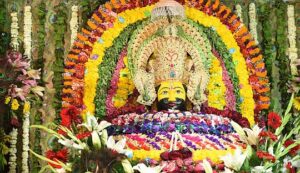
Khatu Shyam Temple, also known as Shyam Baba or Barbarika, holds a significant place in Hindu mythology and devotion, particularly in the Indian states of Rajasthan, Haryana, Uttar Pradesh, and Gujarat.
His legend finds its roots in the epic Mahabharata, where Barbarika, the son of Ghatotkacha and Maurvi, pledges his allegiance to the Pandavas during the Kurukshetra War. Endowed with immense powers by a boon from Lord Shiva, Barbarika is nearly invincible in battle. However, it is his unwavering devotion and willingness to sacrifice that earns him the favor of Lord Krishna. When asked by Krishna to sacrifice his own head to uphold a pledge, Barbarika complies without hesitation. Impressed by his commitment, Krishna grants him the boon that in Kaliyuga, he would be worshipped as Shyam by devotees seeking blessings, protection, and fulfillment of wishes.
The temple of Khatu Shyam Temple, located in the Sikar district of Rajasthan, serves as a focal point for his devotees. It is a site of pilgrimage, drawing thousands of worshippers annually, especially during the Phalguna Mela, a vibrant fair held in February-March. Devotees from various walks of life gather here to express their devotion, seek solace, and offer prayers to Khatu Shyam. The atmosphere during these festivities is filled with spirituality, as devotees sing bhajans (devotional songs) and participate in rituals to honor the deity.
The worship of Khatu Shyam extends beyond the boundaries of the temple. Devotees often establish personal shrines in their homes dedicated to Shyam Baba, where they perform daily prayers and rituals. These acts of devotion serve as a constant reminder of their faith and connection to the divine. Miracles attributed to Khatu Shyam are recounted in the narratives of devotees, further reinforcing their belief in his benevolence and divine intervention in their lives.
Symbolically, Khatu Shyam Temple is often depicted with a peacock feather adorning his head, reminiscent of Lord Krishna. The peacock feather symbolizes beauty, grace, and divine protection, attributes that resonate deeply with his devotees. Additionally, he is sometimes portrayed with a bow and arrow, symbolizing his warrior aspect and his ability to overcome obstacles.
The worship of Khatu Shyam transcends regional boundaries and has gained popularity globally, particularly among the Indian diaspora. His devotees, irrespective of their cultural backgrounds, find solace and spiritual fulfillment in his worship. They believe in his omnipresence and turn to him in times of need, trusting in his ability to alleviate their suffering and fulfill their desires.
Service and charity are integral aspects of devotion to Khatu Shyam. Devotees engage in acts of philanthropy, such as feeding the poor, providing shelter to the homeless, and contributing to charitable causes, as a way of expressing their gratitude and devotion to the deity. These acts of kindness reflect the teachings of compassion and selflessness espoused by Khatu Shyam.
Khatu Shyam, revered as a manifestation of Lord Krishna, symbolizes various virtues and ideals cherished by his devotees. His legend not only illustrates the importance of devotion and sacrifice but also emphasizes the belief in divine intervention and the power of faith. The narrative of Khatu Shyam’s selfless act of sacrificing his own head exemplifies the ultimate test of devotion and underscores the principle of surrendering to the divine will. This profound act resonates deeply with his worshippers, who often strive to emulate his unwavering commitment to righteousness and duty.
The annual Phalguna Mela at the Khatu Shyam temple is a vibrant celebration marked by fervent devotion and communal harmony. During this time, the temple premises come alive with the sounds of bhajans, the fragrance of incense, and the sight of colorful decorations. Pilgrims from far and wide converge at the temple, seeking blessings and participating in various rituals and ceremonies conducted in honor of Khatu Shyam. The atmosphere is imbued with a sense of spirituality and camaraderie as devotees come together to express their reverence and gratitude towards the deity.
Apart from the Phalguna Mela, other festivals such as Janmashtami and Sharad Purnima also hold special significance for devotees of Khatu Shyam. Janmashtami commemorates the birth of Lord Krishna, while Sharad Purnima is believed to be the day when Krishna performed the enchanting Raas Leela with Radha and the Gopis. These festivals are celebrated with great enthusiasm and devotion, with devotees engaging in prayers, fasting, and various religious observances to honor the divine presence of Khatu Shyam.
The worship of Khatu Shyam is not confined to grand festivals and elaborate rituals; it permeates the daily lives of his devotees. Many individuals invoke his name in times of distress, seeking his guidance and protection. It is believed that Khatu Shyam listens to the prayers of his devotees with compassion and grace, offering solace and assistance in their hour of need. This deep-seated faith in the benevolence of the deity instills a sense of hope and resilience among his worshippers, empowering them to face life’s challenges with fortitude and optimism
In conclusion, the worship of Khatu Shyam embodies a deep sense of devotion, faith, and spiritual connection among his followers. His legend, rooted in ancient mythology, continues to inspire millions of devotees worldwide, who seek his blessings for protection, prosperity, and spiritual enlightenment
Read about us : Kedarnath Temple